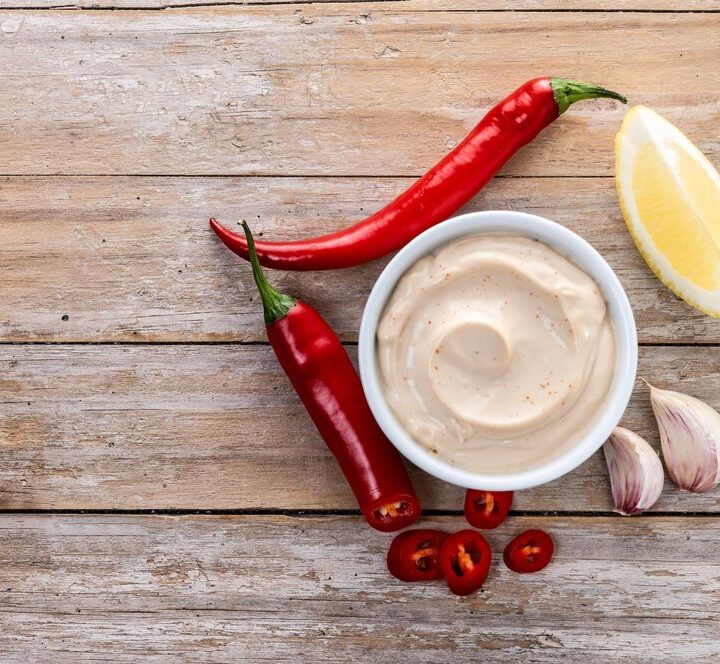Are you looking to add a bold and smoky flavor to your dishes? This chipotle sauce recipe is your answer! Packed with the perfect balance of heat and creaminess, chipotle sauce is a versatile condiment that enhances tacos, sandwiches, salads, and even fries. This guide provides everything you need to create this delicious sauce at home, customize it to your preferences, and explore its many uses.
What Is Chipotle Sauce?
Chipotle sauce is a creamy and smoky condiment made with chipotle peppers in adobo sauce. These peppers are smoked and dried jalapeños, providing the distinct smoky heat that makes the sauce irresistible. When blended with creamy ingredients like mayonnaise or Greek yogurt, the result is a flavorful and versatile sauce commonly used in Mexican and Tex-Mex cuisine.
If you’re curious about the origin of chipotle peppers and their culinary uses, explore this guide to chipotle peppers.
Ingredients for Chipotle Sauce
To make this chipotle sauce recipe, you’ll need simple, pantry-friendly ingredients:
- Chipotle Peppers in Adobo Sauce: Provides smoky heat and depth.
- Mayonnaise: Creates the creamy base. Use vegan mayo for a plant-based option.
- Sour Cream or Greek Yogurt: Adds tanginess to balance the spice.
- Garlic: Enhances the overall flavor.
- Lime Juice: Brightens the sauce with citrusy notes.
- Salt and Pepper: Balances and enhances all the flavors.
How to Make Chipotle Sauce
Follow these simple steps to prepare your own chipotle sauce:
Prepare the Ingredients
- Remove 2-3 chipotle peppers from the can of adobo sauce and chop them finely.
- Peel and mince one garlic clove.
- Juice one fresh lime.
Blend the Sauce
- Combine the chopped chipotle peppers, ½ cup mayonnaise, ¼ cup sour cream or Greek yogurt, minced garlic, lime juice, and a pinch of salt and pepper in a blender or food processor.
- Blend until smooth. For a thinner consistency, add a teaspoon of water or lime juice.
Taste and Adjust
- Sample the sauce and adjust it to your liking:
- Add more chipotle peppers for heat.
- Increase sour cream or mayo for creaminess.
- Squeeze extra lime juice for tanginess.
Chill and Serve
- Transfer the sauce to an airtight container and refrigerate for at least 30 minutes. This resting time allows the flavors to meld.
Variations of Chipotle Sauce
One of the best aspects of this chipotle sauce recipe is its versatility. Whether you’re catering to specific dietary needs or experimenting with flavors, this sauce can be easily adapted:
1. Vegan Chipotle Sauce
- Replace mayonnaise with vegan mayo and use a dairy-free yogurt or sour cream alternative for creaminess.
- This option retains the smoky, spicy flavor while being completely plant-based, making it perfect for vegans or those with dairy allergies.
- Explore vegan mayonnaise alternatives to find a brand that suits your preferences.
2. Sweet and Spicy Chipotle Sauce
- Add a teaspoon of honey, agave syrup, or maple syrup to balance the heat with a touch of sweetness.
- This variation pairs beautifully with roasted vegetables, chicken wings, or as a dipping sauce for spicy snacks.
- For a deeper caramelized flavor, consider blending in a drizzle of molasses.
3. Low-Calorie Version
- Use Greek yogurt as the primary base instead of mayonnaise. This not only lowers the calorie content but also adds a tangy note to the sauce.
- Perfect for health-conscious individuals or those watching their fat intake. For an even lighter option, opt for non-fat Greek yogurt.
4. Extra Smoky Chipotle Sauce
- Intensify the smoky flavor by adding a dash of smoked paprika or liquid smoke.
- This variation is ideal for barbecue lovers, as it enhances the depth of flavor in marinades, burger toppings, and barbecue platters.
5. Herb-Infused Chipotle Sauce
- Add fresh herbs like cilantro, parsley, or chives to give the sauce a vibrant, herbaceous twist.
- This works well as a salad dressing or as a topping for grilled fish and seafood.
Want to make your chipotle sauce even fresher? Try preparing your own mayonnaise with this easy homemade mayonnaise recipe.

How to Use Chipotle Sauce
Chipotle sauce is a culinary multitasker, adding smoky, spicy, and creamy goodness to any meal. Here are some of the best ways to incorporate it into your cooking:
1. As a Dip
- Serve chipotle sauce alongside fries, tortilla chips, onion rings, or raw vegetables for a flavorful and satisfying snack.
- It’s a great alternative to traditional dips like ranch or aioli, offering a smoky twist that pairs well with crispy textures.
2. As a Topping
- Drizzle the sauce over tacos, burritos, enchiladas, or quesadillas to elevate your favorite Mexican dishes.
- Check out this enchiladas recipe to see how well chipotle sauce complements spicy fillings and cheesy toppings. (Placeholder for internal link.)
3. As a Spread
- Use chipotle sauce as a sandwich or burger spread to replace traditional condiments like ketchup or mustard.
- Its smoky and creamy flavor adds depth to grilled cheese sandwiches, BLTs, and turkey wraps.
4. In Marinades
- Mix the sauce into marinades for chicken, shrimp, steak, or tofu.
- The smoky heat penetrates the protein, enhancing the flavor when grilled, baked, or roasted.
5. As a Salad Dressing
- Thin the sauce with olive oil, lime juice, or apple cider vinegar to create a zesty dressing for salads or grain bowls.
- Use it to dress a Southwest-style salad with black beans, corn, and avocado for a bold flavor profile.
6. In Pasta or Rice Dishes
- Stir the sauce into pasta or rice for an instant smoky and creamy upgrade.
- Chipotle sauce works especially well in mac and cheese, risottos, or as a topping for baked potatoes.
The versatility of this chipotle sauce recipe ensures it will quickly become a staple in your kitchen.
Storing and Shelf Life
Proper storage is key to maintaining the freshness and flavor of your chipotle sauce recipe. Follow these tips to enjoy your sauce for as long as possible:
1. Refrigeration
- Transfer the sauce to an airtight container and store it in the refrigerator.
- It will stay fresh for up to 7 days, making it an excellent option for meal prep.
2. Freezing
- To extend its shelf life, freeze the sauce in a freezer-safe container or ice cube trays.
- Once frozen, transfer the cubes to a resealable bag for easy portioning. Thaw in the refrigerator before use, and stir well to restore its smooth texture.
3. Signs of Spoilage
- Discard the sauce if you notice:
- A sour or off smell.
- Discoloration or a grayish hue.
- Separation of liquids that cannot be mixed back together.
Storing your chipotle sauce properly ensures it retains its bold, smoky flavor and creamy consistency.
Health Benefits and Adjustments
Chipotle sauce is more than just delicious—it can be tailored to meet various dietary needs and health goals. Here’s how to make it work for you:
1. Low-Fat Adjustments
- Replace mayonnaise with non-fat Greek yogurt or low-fat sour cream to reduce calories and fat without sacrificing creaminess.
- This adjustment makes the sauce lighter and tangier, ideal for health-conscious recipes.
2. Low-Sodium Option
- Reduce the salt in the recipe and use low-sodium versions of mayonnaise or sour cream.
- This makes the sauce a heart-healthy option for those watching their sodium intake.
3. Gluten-Free Assurance
- The recipe is naturally gluten-free, but double-check labels on store-bought ingredients like chipotle peppers in adobo sauce. Some brands may contain additives that include gluten.
4. High-Protein Boost
- Increase the protein content by using Greek yogurt as the primary base. This not only adds creaminess but also makes the sauce a nutritious addition to post-workout meals.
Nutritional Information (Per 1 Tablespoon):
- Calories: 45
- Fat: 4g
- Carbohydrates: 1g
- Protein: 1g
By incorporating these adjustments, you can enjoy the smoky, spicy flavors of this chipotle sauce recipe while adhering to your dietary needs.

Frequently Asked Questions
How Do You Make Chipotle Sauce From Scratch?
Making chipotle sauce from scratch is simple and requires only a few basic ingredients. Here’s a step-by-step guide:
- Gather Ingredients:
- Chipotle peppers in adobo sauce (2-3 peppers) for the smoky, spicy flavor.
- Mayonnaise or Greek yogurt for creaminess.
- Garlic, lime juice, and a pinch of salt to enhance the flavors.
- Blend Ingredients:
Combine the chipotle peppers, ½ cup mayonnaise, ¼ cup sour cream (or Greek yogurt), a clove of garlic, and freshly squeezed lime juice in a blender. Blend until smooth. - Taste and Adjust:
Adjust the spice level by adding more chipotle peppers for heat or increasing mayonnaise for a milder taste. For a thinner consistency, mix in a splash of water or lime juice. - Chill and Serve:
Refrigerate the sauce for 30 minutes to allow the flavors to meld before serving.
This chipotle sauce recipe delivers a bold, smoky flavor perfect for tacos, dips, and marinades. It’s easy to customize for dietary preferences, making it a versatile condiment for any dish.
What Sauce Is Closest to Chipotle?
If you’re looking for a sauce that closely mimics the flavor of chipotle sauce, consider the following options:
- Smoked Paprika Mayo: A combination of mayonnaise and smoked paprika offers a similar smoky flavor, though it lacks the heat of chipotle peppers.
- Adobo Sauce: The sauce from canned chipotle peppers in adobo is a direct alternative. Blend it with sour cream or mayonnaise to achieve a creamy consistency.
- Harissa Sauce: This North African chili paste has a smoky, spicy profile that can serve as a substitute in some recipes.
- Buffalo Sauce with Smoked Paprika: While buffalo sauce lacks the creaminess, adding smoked paprika brings it closer to chipotle’s smoky flavor.
For the most authentic experience, using actual chipotle peppers is recommended, as they deliver the unique balance of smokiness and heat found in any authentic chipotle sauce recipe.
What to Use Chipotle Sauce For?
Chipotle sauce is an incredibly versatile condiment. Here are some popular ways to use it:
- As a Dip: Serve with fries, tortilla chips, onion rings, or raw vegetables.
- As a Topping: Drizzle over tacos, burritos, enchiladas, or nachos for a smoky kick. Pair it with this homemade enchiladas recipe. (Placeholder for an internal link to your enchilada recipe.)
- As a Marinade: Use the sauce to marinate chicken, shrimp, or steak before grilling or baking. The smoky flavor penetrates the protein for a delicious result.
- As a Burger Spread: Replace traditional condiments like ketchup with chipotle sauce to elevate your burgers and sandwiches.
- In Salads and Bowls: Thin it out with olive oil or lime juice to make a zesty salad dressing. It’s perfect for grain bowls or Mexican-inspired salads.
Chipotle sauce adds depth and a smoky, spicy flavor to any dish, making it a must-have in your culinary arsenal.
Is Chipotle Sauce Like Buffalo Sauce?
While both chipotle sauce and buffalo sauce are popular condiments, they are quite different in terms of flavor and ingredients:
- Flavor Profile:
- Chipotle Sauce: Smoky and creamy with moderate heat, thanks to the chipotle peppers. It has a richer, more complex flavor profile.
- Buffalo Sauce: Tangy and vinegary with a strong kick of heat from hot sauce and butter. It’s often thinner in consistency.
- Main Ingredients:
- Chipotle Sauce: Made with chipotle peppers, mayonnaise or sour cream, garlic, and lime juice.
- Buffalo Sauce: A combination of hot sauce (like Frank’s RedHot) and melted butter.
- Best Uses:
- Chipotle Sauce: Great as a dip, marinade, or topping for Mexican and Tex-Mex dishes.
- Buffalo Sauce: Typically used for coating chicken wings or as a dipping sauce for fried foods.
In short, while both sauces add spice to dishes, chipotle sauce leans towards creamy and smoky flavors, making it more versatile for a wider range of cuisines.
Serving Suggestions
Pair your chipotle sauce recipe with these dishes for a complete meal:
- Tacos and Burritos: Drizzle the sauce over tacos or burritos for a smoky, spicy boost. Try it with this Breakfast burrito recipe. (Placeholder for internal link to burrito recipes on your site.)
- Roasted Vegetables: Add flavor to roasted zucchini, carrots, or sweet potatoes with a chipotle drizzle.
- Fried Foods: Use as a dip for fries, chicken tenders, or onion rings.
- Breakfast Dishes: Add a dollop to scrambled eggs or breakfast burritos for a spicy kick.

Conclusion
This chipotle sauce recipe is a must-have in your culinary arsenal. Its bold, smoky, and creamy flavors can transform ordinary meals into extraordinary experiences. Whether you’re using it as a dip, marinade, or topping, the versatility of chipotle sauce makes it a favorite for home cooks and food enthusiasts alike.
Start experimenting with this recipe today, and don’t be afraid to customize it to suit your taste. With simple ingredients and endless possibilities, this sauce is sure to become a staple in your kitchen.





